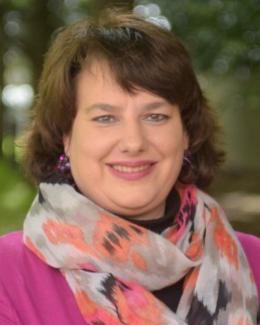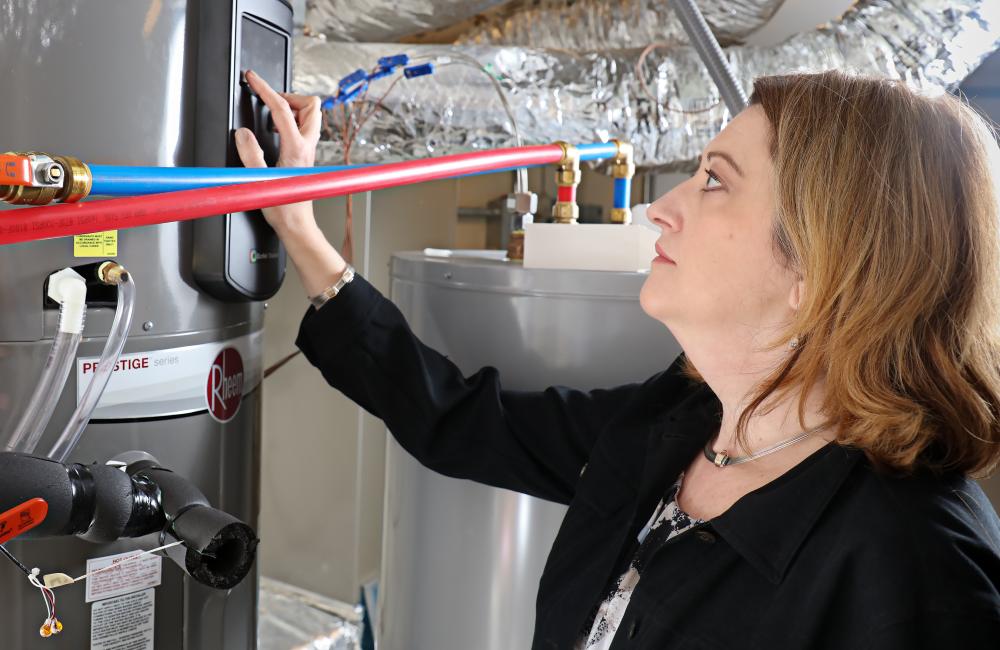A few miles from Oak Ridge National Laboratory (ORNL) sits a quiet house in a suburban neighborhood. The exterior is just like the neighbors', but inside the home there's a unique buzz of activity supervised by Heather Buckberry, a mechanical engineer with a wealth of experience designing new buildings for maximum energy efficiency.
Buckberry is project manager for ORNL's involvement in industry partner Southern Company's Smart Neighborhood, the Southeast's first community custom-built to generate, store, and use its own electricity-a system known as a microgrid. The ambitious 62-home project developed by Southern's Alabama Power subsidiary in Hoover, Alabama, provides ORNL's research team the opportunity to demonstrate software applications that give homeowners concise control over electricity usage.
ORNL's East Tennessee research home serves as the testbed for the control applications that Southern Company is deploying- demonstrating transactive controls and including everything from a microgrid controller to advanced sensors gathering data from smart appliances and heating/cooling systems to manage a home's entire power load.
"The Smart Neighborhood project is a great demonstration of the near-term reality of what will be happening in the buildings space," said Buckberry. "It's also one of the most rewarding projects I've had the opportunity to work on at ORNL."
Working on collaborative research projects that can have a positive impact on building technology has always been important to Buckberry, and one of the reasons she joined ORNL in 2011 after leaving a successful career in the private sector designing factory buildings for the automotive and aircraft manufacturing industries. "In this type of work, you are limited in how innovative you can be because the buildings all have similar designs. I was ready to make the change to advanced energy efficiency work," she said.
Buckberry became intrigued by the opportunities that were just beginning to emerge in building technology at ORNL. Soon after joining the lab as a project manager, she was involved in the construction of several buildings that serve as the cornerstone of the Building Technologies Research and Integration Center (BTRIC), including platforms for large-scale building envelope design and concepts for next-generation home appliances. Buckberry also directly managed the installation of two large-scale environmental chambers for the Heating, Ventilation, and Air Conditioning (HVAC) lab and the building envelope lab.
"It was an exciting time because I was able to see some new apparatus assembled and the online deployment of instrumentation and data, which was being fed back to the lab for research," she said.
When the BTRIC campus construction was completed, Buckberry's duties shifted overseas to provide technical demonstration support with U.S. Pacific Command. She spent three weeks in Thailand and three weeks in the Philippines, assessing energy efficient commercial solutions for operating bases. "We looked at technology in the field for the Marine Corps, focusing on how well base technology would perform in a tropical environment," she said. In Thailand, Buckberry worked with the Royal Thai Military, similar to the U.S. version of West Point. She was one of only a few females in the engineering group. "It was hard to deal with the tropics; and in the Philippines, we were not only in an incredibly hot and humid area, but also on top of a dry lava bed, so that added another layer to the environmental challenges," she said.
Accepting and overcoming challenges has long been a part of Buckberry's life. Growing up in Sevier County, Tennessee, she had a knack for figuring out how things work. "I always loved taking machines apart and understanding how they operate," she said.
That interest in functionality and how things work led Buckberry to pursue an undergraduate degree in mechanical engineering from Johns Hopkins University. She completed her master's degree in engineering management at the University of Tennessee, Knoxville, and she is certified as a professional engineer in mechanical engineering and fire protection engineering.
Although Buckberry's work days are spent monitoring ORNL's residential research home, she hasn't added too much smart technology to her own home just yet. "I recently restored two 100-plus-year-old sewing machines," she said. "Once I got the machines broken down, it turned out they really just needed cleaning. The original steel and cast-iron components still operated fine. Now the machines sew smoothly with beautiful, straight stitches. Once I rehabbed those, I decided to restore an antique trunk and a primitive pie safe. I've since learned a bit about refinishing and furniture joinery-including what I should pay more attention to the next time I decide to go antiquing."
ORNL is managed by UT-Battelle for the Department of Energy's Office of Science, the single largest supporter of basic research in the physical sciences in the United States. DOE's Office of Science is working to address some of the most pressing challenges of our time. For more information, please visit http://energy.gov/science.



